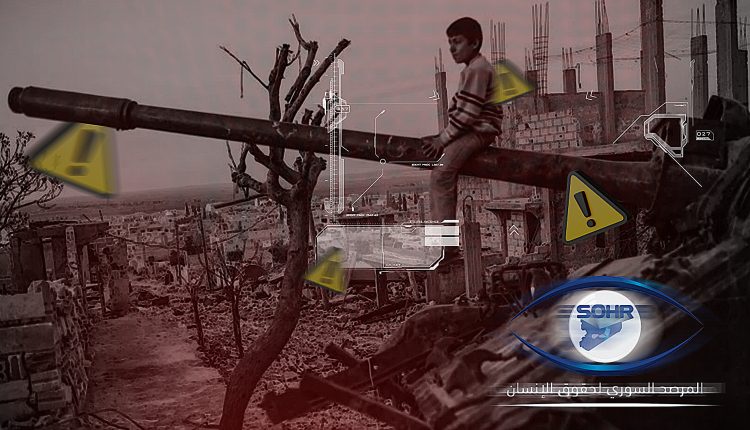The Syrian Observatory for Human Rights (SOHR) has published a booklet summarizing all the major developments in Syria in August 2023. The Observatory, which has been following all developments on the ground, aims to shed light on the plight of the Syrian people by presenting all the violations and crimes committed against them that are monitored and documented. According to the booklet, 440 people were killed in August 2023, which is the highest number of deaths in the last 19 months. Among the 440 killed were 164 civilians, including 34 children and 14 women.
Most abductions and arbitrary arrests in Syrian and Turkish-held areas
The booklet further reveals that nearly 265 arrests and kidnappings have taken place across Syria in the last month. The SOHR documented the kidnapping of 37 people, including two children and two young women, and the arbitrary arrests of 227 others, including six children and 11 women. The data show that the majority of abductions and arbitrary arrests occurred on Syrian government territory and in the territories of Turkish-backed factions. The Observatory notes that the number of abductees is much higher, but the families of the victims prefer to keep their sons’ identities secret. They fear persecution and punishment by the authorities who arrested or kidnapped them. The SOHR calls for ‘the inspection of prisons across Syria, especially in regime-held areas’.
Unexploded ordnance has claimed many lives
Explosions have also been a cause of death and injury. According to the SOHR, 25 of the 32 people killed in explosions were children and women. It reiterated its call to the relevant international bodies to urgently address the problem and remove old unexploded ordnance from Syria. It is also underlined that unexploded ordnance, which has been planted by military formations all over the geography of Syria for more than 11 years, has tragically caused the death and injury of a large number of people.
Turkey reinforces troops in the region
In what SOHR calls the ‘Putin-Erdogan’ region, where around 120 people have been killed, a significant increase in air and ground attacks has led to the highest monthly death toll yet in 2023. The SOHR notes that the ‘de-escalation zone’, which stretches from the north-eastern mountains of Latakia to the north-western suburbs of Aleppo, is under a ‘so-called’ ceasefire in all but name, agreed following a meeting between Russian President Vladimir Putin and Turkish President Recep Tayyip Erdogan in March 2020. According to the Observatory, there has been a significant escalation in military operations by Russian and Syrian forces and their militias.
The booklet also provides the following information on the subject: “Meanwhile, Turkey, ‘the de-escalation’ guarantor, seems satisfied with its ‘timid’ bombardement of regime positions, which has not restrained this alarming military escalation. Turkish forces continued reinforcing their military bases in the “Putin-Erdogan” area, in addition to suddenly replacing all officers in the region with others from outside of the region. Three batches of military reinforcement crossed into Syria through Bab al-Hawa and Kafr Lusin crossings on the border between Syria and Turkey, including military and logistical supplies and equipment, armored vehicles and trucks carrying cement blocks.”
Humanitarian crises in Turkish-occupied areas
The report also documents the abduction and arbitrary detention of 52 people and more than 45 cases of human rights violations in the Turkish-occupied Afrin canton in the past month. The SOHR states: “Since Turkish forces and their proxy factions captured several areas in north-western Aleppo, namely Afrin canton, after a military operation known as ‘Olive Branch’, humanitarian crises have been emerging and worsening gradually, with violations, attacks and explosions occurring almost daily.”
It is noted that the same situation applies in the areas captured in Aleppo following the Turkish military operation known as “Euphrates Shield”. In addition, human rights violations have escalated in areas under the control of Turkish forces and their proxies in Hasakah and Raqqa, known as the ‘Peace Spring’ areas, since they were invaded in October 2019. The Observatory states that these forces aim to achieve certain economic and political objectives by exploiting the wealth, resources and people of the regions. Citing the conflict in Deir ez-Zor, SOHR adds that the military escalation by Turkish forces in the Autonomous Administration areas is continuing. It is also said that Iran, which is making military reinforcements to strengthen its presence in Syria and spread its ideology, is aiming to create demographic changes in different regions of Syria as part of its systematic plan.
ISIS is still alive and kicking
Meanwhile, ISIS continued to attack areas of the Autonomous Administration over the last month. The booklet reveals that there is a dramatic escalation of ISIS attacks in the Syrian desert, and that sleeper cells carried out 20 attacks in SDF-controlled areas. The SOHR states: “ISIS cells are still able to exploit opportunities to create a security vacuum and carry out assassinations, which clearly indicates that the ‘Islamic State’ is still alive and kicking.” The Observatory recalled that it had been warning about the resurgence of ISIS from the very beginning. The SOHR called on the international community to work hard to stop the bloodshed in Syria.

